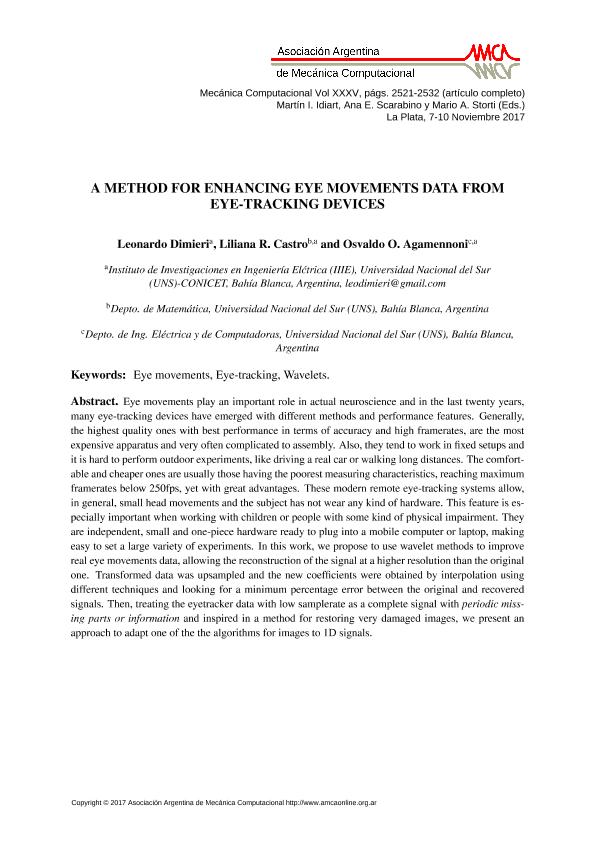Artículo
A method for enhancing eye movements data from eye-tracking devices
Fecha de publicación:
11/2017
Editorial:
Asociación Argentina de Mecánica Computacional
Revista:
Mecánica Computacional
ISSN:
2591-3522
Idioma:
Inglés
Tipo de recurso:
Artículo publicado
Clasificación temática:
Resumen
Eye movements play an important role in actual neuroscience and in the last twenty years, many eye-tracking devices have emerged with different methods and performance features. Generally, the highest quality ones with best performance in terms of accuracy and high framerates, are the most expensive apparatus and very often complicated to assembly. Also, they tend to work in fixed setups and it is hard to perform outdoor experiments, like driving a real car or walking long distances. The comfortable and cheaper ones are usually those having the poorest measuring characteristics, reaching maximum framerates below 250fps, yet with great advantages. These modern remote eye-tracking systems allow, in general, small head movements and the subject has not wear any kind of hardware. This feature is especially important when working with children or people with some kind of physical impairment. They are independent, small and one-piece hardware ready to plug into a mobile computer or laptop, making easy to set a large variety of experiments. In this work, we propose to use wavelet methods to improve real eye movements data, allowing the reconstruction of the signal at a higher resolution than the original one. Transformed data was upsampled and the new coefficients were obtained by interpolation using different techniques and looking for a minimum percentage error between the original and recovered signals. Then, treating the eyetracker data with low samplerate as a complete signal with periodic missing parts or information and inspired in a method for restoring very damaged images, we present an approach to adapt one of the the algorithms for images to 1D signals.
Palabras clave:
Eye Movement
,
Eye-Tracking
,
Wavelets
Archivos asociados
Licencia
Identificadores
Colecciones
Articulos(IIIE)
Articulos de INST.DE INVEST.EN ING.ELECTRICA "A.DESAGES"
Articulos de INST.DE INVEST.EN ING.ELECTRICA "A.DESAGES"
Citación
Dimieri, Leonardo Daniel; Castro, Liliana Raquel; Agamennoni, Osvaldo Enrique; A method for enhancing eye movements data from eye-tracking devices; Asociación Argentina de Mecánica Computacional; Mecánica Computacional; XXXV; 43; 11-2017; 2521-2532
Compartir




